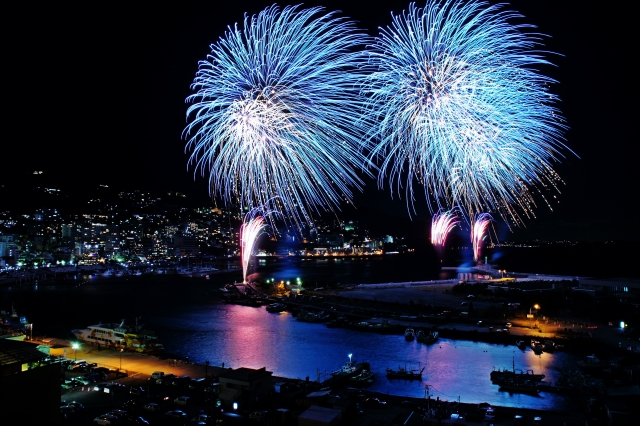Why Have Fireworks in the Summer?
Japanese fireworks or hanabi is now said to be the most beautiful in the world and it is exported to about 20 countries worldwide. It is said though that there is a longer history of fireworks and gunpowder in Europe and China. In Japan, hanabi has been deeply intertwined with culture and tradition and came to be enjoyed as it is in the present-day hanabi festival.

When we hear of “fireworks” overseas, there is the sense that they are associated with celebrations such as a New Year’s count-down or the July 4th Independence Day celebrations in the U.S. What is special about Japanese hanabi is that there are “hanabi-taikai” or special events to enjoy the hanabi alone.
So why do we have hanabi only in the summertime?
Hanabi as an Expression of Beauty
It is said that the first person to have seen hanabi in Japan is Tokugawa Ieyasu (1543-1616). Since then, hanabi has become super popular. Hanabi has been prohibited many times due to the fires it has caused. But when you think about the numerous times they had to give out the order, you can see how much the people continued doing it even after it was prohibited and how popular it was!
The spark of the hanabi in the old days was red-orange in colour. When you look at the ukiyo-e, hanabi is depicted in one colour, in red-orange. It seems that around the Meiji Restoration, various colorants were imported from overseas. The pursuit for beauty has influenced people to look for a way to create multi-coloured hanabi.
Pursuing “beauty” in hanabi is perhaps specific to Japan. In other countries, it seems like people are looking to see loud sounds and the power of explosion, similar to the excitement of seeing a rocket being shot up in the sky. Though they are grouped in the same “fireworks” category, they seem like two completely different things. It is said that in countries like Italy and Spain, people get upset and complain if they don’t hear the loud sounds of explosion.
The sounds the Japanese hanabi makes may not be as loud as the ones overseas but the Japanese hanabi also uses “sound” as a method of expression. If you have seen a Japanese hanabi, you may have heard the sharp whistling sound when the fireworks go up. This is due to a whistling device that is actually put in the firework to create the sound.
The whistling sound, silence…boom! By using the whistling sound in this way, a moment of silence is created between the light and sound. By emphasising this silent moment, it draws the viewers’ attention, and generates anticipation toward what is happening next. This “space” is an aesthetic specific to Japan. This concept is incorporated for example in haiku poetry or even when making a Japanese garden. This kind of intention shows that hanabi is not just a fun entertainment but an art in itself.
Reasons for Having Hanabi in the Summer
Hanabi of the 8th Shogun Tokugawa Yoshimune
In 1733, the Shogun Yoshimune ordered for several fireworks to be shot up by the current Sumidagawa River (called Ryogoku Okawa at the time). This was done at the timing of “kawabiraki (opening of the river)” to console the spirits of the deceased and to ward off the evil spirits. The reason for this order was because in the previous year, there were numerous deaths due to famine and cholera. Since then, it has become tradition to shoot hanabi on the first day of the kawabiraki. The Sumidagawa Hanabi-Taikai also has its roots here.
To Enjoy the Cool of the Evening
It was previously mentioned that Tokugawa Yoshimune’s hanabi was held on the first day of the kawabiraki. What then is the kawabiraki?
The kawabiraki was the period between May 28th to August 26th of the lunar calendar when people gathered by the river to escape the heat. We do not hear of the word kawabiraki nowadays, but like umibiraki (the beach) and yamabiraki (the mountain), what it basically means is that it’s a declaration to say, “we will start the season of having fun by the river”.
During the kawabiraki period, business for hotels on boats or restaurants facing the river were bustling. People would go out on the river in boats, eat and drink by the river and hold parties to escape the heat. Throughout the summer in Edo, people would stay by the river to keep cool and the Ryogoku-bashi Bridge was filled with excitement.
To provide some entertainment for the guests during this time, the restaurants and teahouses in the Ryogoku area all contributed towards shooting up hanabi. It seems that the custom of watching the hanabi during the hot summers was born out of this tradition of having hanabi during the kawabiraki season, an event to escape the heat. I can see how gazing at the reflection of the beautiful hanabi on the river surface can help take your mind off the summer heat.
The Obon Okuribi
Obon generally refers to the period between August 13th to August 16th and it is the period when the “ancestral spirits come back to visit us”. During this period “fire” holds a very important meaning. On the 13th, we burn a fire to welcome the spirits of the ancestors (mukaebi) and on the 16th, we burn a fire to see them off when they depart (okuribi). The Kyoto Daimonji and Toro Nagashi (Lantern Festival) is also considered a form of okuribi. Similarly, the hanabi also had a purpose of seeing the ancestral spirits off, as a form of okuribi. You will see that we still have many hanabi festivals that are held in August around obon. So if you are here in Japan during summertime, please do check out our hanabi festivals!










